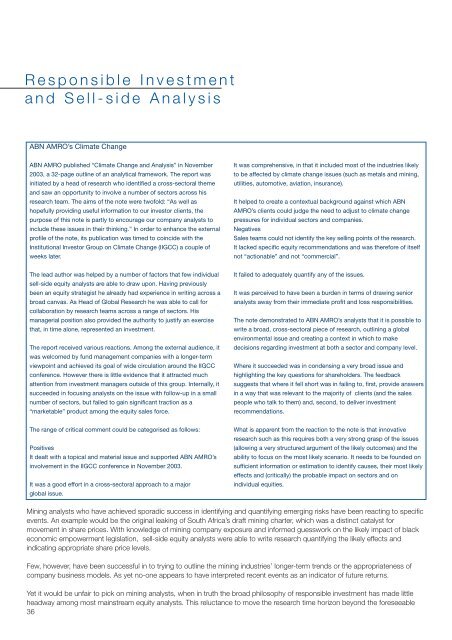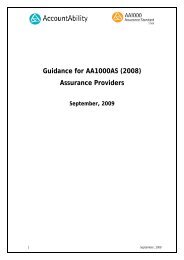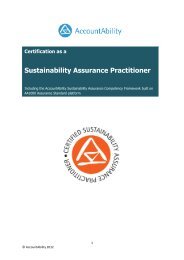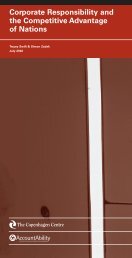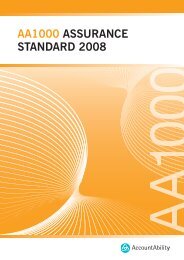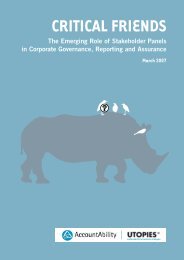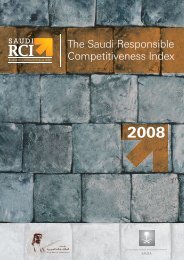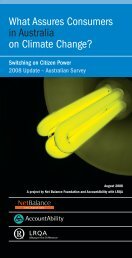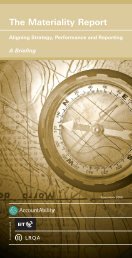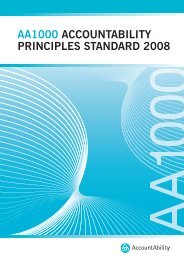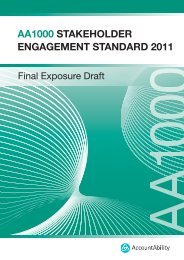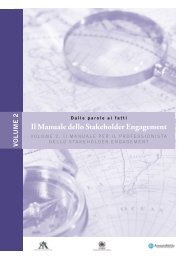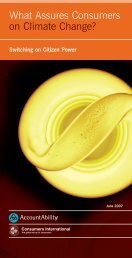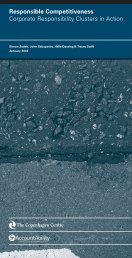Mainstreaming Responsible Investment - AccountAbility
Mainstreaming Responsible Investment - AccountAbility
Mainstreaming Responsible Investment - AccountAbility
Create successful ePaper yourself
Turn your PDF publications into a flip-book with our unique Google optimized e-Paper software.
<strong>Responsible</strong> <strong>Investment</strong><br />
and Sell-side Analysis<br />
ABN AMRO’s Climate Change<br />
ABN AMRO published “Climate Change and Analysis” in November<br />
2003, a 32-page outline of an analytical framework. The report was<br />
initiated by a head of research who identified a cross-sectoral theme<br />
and saw an opportunity to involve a number of sectors across his<br />
research team. The aims of the note were twofold: “As well as<br />
hopefully providing useful information to our investor clients, the<br />
purpose of this note is partly to encourage our company analysts to<br />
include these issues in their thinking.” In order to enhance the external<br />
profile of the note, its publication was timed to coincide with the<br />
Institutional Investor Group on Climate Change (IIGCC) a couple of<br />
weeks later.<br />
It was comprehensive, in that it included most of the industries likely<br />
to be affected by climate change issues (such as metals and mining,<br />
utilities, automotive, aviation, insurance).<br />
It helped to create a contextual background against which ABN<br />
AMRO’s clients could judge the need to adjust to climate change<br />
pressures for individual sectors and companies.<br />
Negatives<br />
Sales teams could not identify the key selling points of the research.<br />
It lacked specific equity recommendations and was therefore of itself<br />
not “actionable” and not “commercial”.<br />
The lead author was helped by a number of factors that few individual<br />
sell-side equity analysts are able to draw upon. Having previously<br />
been an equity strategist he already had experience in writing across a<br />
broad canvas. As Head of Global Research he was able to call for<br />
collaboration by research teams across a range of sectors. His<br />
managerial position also provided the authority to justify an exercise<br />
that, in time alone, represented an investment.<br />
The report received various reactions. Among the external audience, it<br />
was welcomed by fund management companies with a longer-term<br />
viewpoint and achieved its goal of wide circulation around the IIGCC<br />
conference. However there is little evidence that it attracted much<br />
attention from investment managers outside of this group. Internally, it<br />
succeeded in focusing analysts on the issue with follow-up in a small<br />
number of sectors, but failed to gain significant traction as a<br />
“marketable” product among the equity sales force.<br />
It failed to adequately quantify any of the issues.<br />
It was perceived to have been a burden in terms of drawing senior<br />
analysts away from their immediate profit and loss responsibilities.<br />
The note demonstrated to ABN AMRO’s analysts that it is possible to<br />
write a broad, cross-sectoral piece of research, outlining a global<br />
environmental issue and creating a context in which to make<br />
decisions regarding investment at both a sector and company level.<br />
Where it succeeded was in condensing a very broad issue and<br />
highlighting the key questions for shareholders. The feedback<br />
suggests that where it fell short was in failing to, first, provide answers<br />
in a way that was relevant to the majority of clients (and the sales<br />
people who talk to them) and, second, to deliver investment<br />
recommendations.<br />
The range of critical comment could be categorised as follows:<br />
Positives<br />
It dealt with a topical and material issue and supported ABN AMRO’s<br />
involvement in the IIGCC conference in November 2003.<br />
It was a good effort in a cross-sectoral approach to a major<br />
global issue.<br />
What is apparent from the reaction to the note is that innovative<br />
research such as this requires both a very strong grasp of the issues<br />
(allowing a very structured argument of the likely outcomes) and the<br />
ability to focus on the most likely scenario. It needs to be founded on<br />
sufficient information or estimation to identify causes, their most likely<br />
effects and (critically) the probable impact on sectors and on<br />
individual equities.<br />
Mining analysts who have achieved sporadic success in identifying and quantifying emerging risks have been reacting to specific<br />
events. An example would be the original leaking of South Africa’s draft mining charter, which was a distinct catalyst for<br />
movement in share prices. With knowledge of mining company exposure and informed guesswork on the likely impact of black<br />
economic empowerment legislation, sell-side equity analysts were able to write research quantifying the likely effects and<br />
indicating appropriate share price levels.<br />
Few, however, have been successful in to trying to outline the mining industries’ longer-term trends or the appropriateness of<br />
company business models. As yet no-one appears to have interpreted recent events as an indicator of future returns.<br />
Yet it would be unfair to pick on mining analysts, when in truth the broad philosophy of responsible investment has made little<br />
headway among most mainstream equity analysts. This reluctance to move the research time horizon beyond the foreseeable<br />
36


